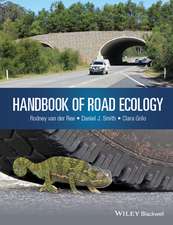Mixed-Species Groups of Animals: Behavior, Community Structure, and Conservation
Autor Eben Goodale, Guy Beauchamp, Graeme D. Ruxtonen Limba Engleză Paperback – 27 apr 2017
They are found in a wide range of animals, including invertebrates, fish, mammals and birds, and in different habitats, both terrestrial and aquatic, throughout the world.
While there are more than 500 articles on this subject scattered in separate categories of journals, there has yet to be a general, cross-taxa book-length introduction to this subject that summarizes the behavior and community structure of these groups.
The authors first survey the diversity of spatial associations among animals and then concentrate on moving groups. They review the major classes of theories that have been developed to explain their presence, particularly in how groups increase foraging efficiency and decrease predation. Finally, they explore the intricacies of species interactions, such as communication, that explain species roles in groups and discuss what implications these social systems have for conservation.
- Functions as a single resource for readers inside and outside of academia on mixed-species groups, serving as a foundation for future research in this field
- Begins with an empirical summary of mixed-species distribution and reviews how the theories explaining their adaptive benefits are supported by the evidence
- Includes many aspects of mixed-group behavior (e.g. foraging, communication, collective decision-making, dominance, social roles of species and leadership, relationship to conservation) that were not previously or easily accessible
Preț: 313.19 lei
Preț vechi: 370.72 lei
-16% Nou
Puncte Express: 470
Preț estimativ în valută:
59.93€ • 62.73$ • 49.88£
59.93€ • 62.73$ • 49.88£
Carte tipărită la comandă
Livrare economică 24 martie-07 aprilie
Preluare comenzi: 021 569.72.76
Specificații
ISBN-13: 9780128053553
ISBN-10: 0128053550
Pagini: 216
Dimensiuni: 152 x 229 x 11 mm
Greutate: 0.34 kg
Editura: ELSEVIER SCIENCE
ISBN-10: 0128053550
Pagini: 216
Dimensiuni: 152 x 229 x 11 mm
Greutate: 0.34 kg
Editura: ELSEVIER SCIENCE
Cuprins
1. Introduction2. A Diversity of Mixed-Species Associations3. Moving Mixed-Species Groups in Different Taxa4. Adaptive Implications of Mixed-Species Grouping: Foraging, Physical, and Reproductive Factors5. Adaptive Implications of Mixed-Species Grouping: Predators and Other Antagonists6. Communication7. Leadership and Sentinel Behavior8. Mixed-Species Groups and Conservation9. Conclusions
Recenzii
"In summary, this is a thorough and concise book on mixed-species animal groups, and functions as a single resource for anyone who is interested in the study of this topic. It is very useful for both undergraduates and post-graduates, as well as for those outside of academia, and so I would thoroughly recommend it for a university library and for anyone who is considering research within this area." --Primate Eye
"...it is a rich, although not exhaustive, source of information on MSGs. ...I enjoyed reading it and learned a lot, and fully recommend it to everybody interested in mixed-species groups." --The Quarterly Review of Biology
"I found the book fascinating in its breadth and now have a much broader and deeper appreciation of mixed-species groups. The authors present frameworks that can be used to guide future research, highlight future research questions, and point out how new methods may enhance our knowledge of both mechanism and function." --Primates
"It will be useful to a broad readership, from students who look for a thorough introduction to the phenomenon to researchers and university lecturers who want to have a single resource on mixed-species troops at hand…I enjoyed reading it and learned a lot, and fully recommend it to everybody interested in mixed-species groups." --Primates
"...it is a rich, although not exhaustive, source of information on MSGs. ...I enjoyed reading it and learned a lot, and fully recommend it to everybody interested in mixed-species groups." --The Quarterly Review of Biology
"I found the book fascinating in its breadth and now have a much broader and deeper appreciation of mixed-species groups. The authors present frameworks that can be used to guide future research, highlight future research questions, and point out how new methods may enhance our knowledge of both mechanism and function." --Primates
"It will be useful to a broad readership, from students who look for a thorough introduction to the phenomenon to researchers and university lecturers who want to have a single resource on mixed-species troops at hand…I enjoyed reading it and learned a lot, and fully recommend it to everybody interested in mixed-species groups." --Primates













